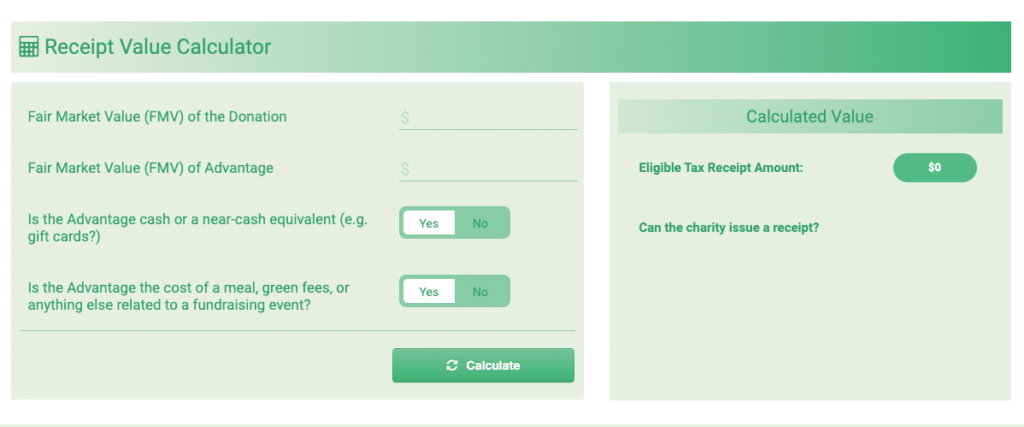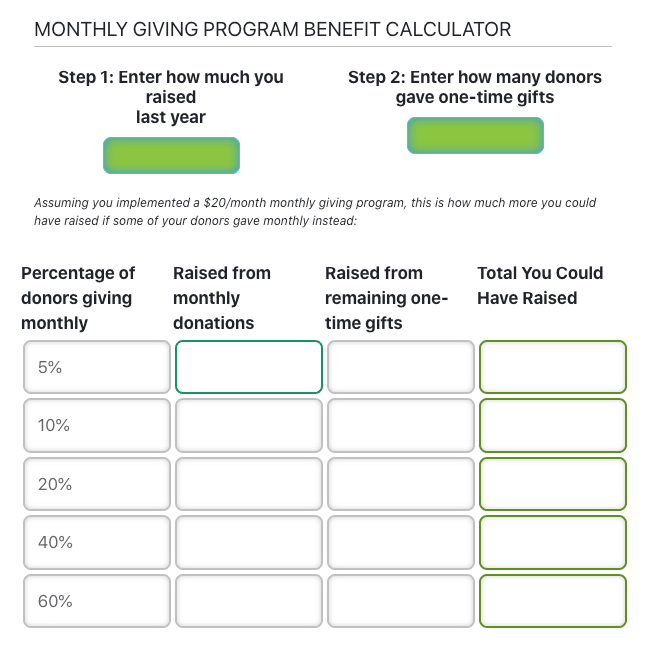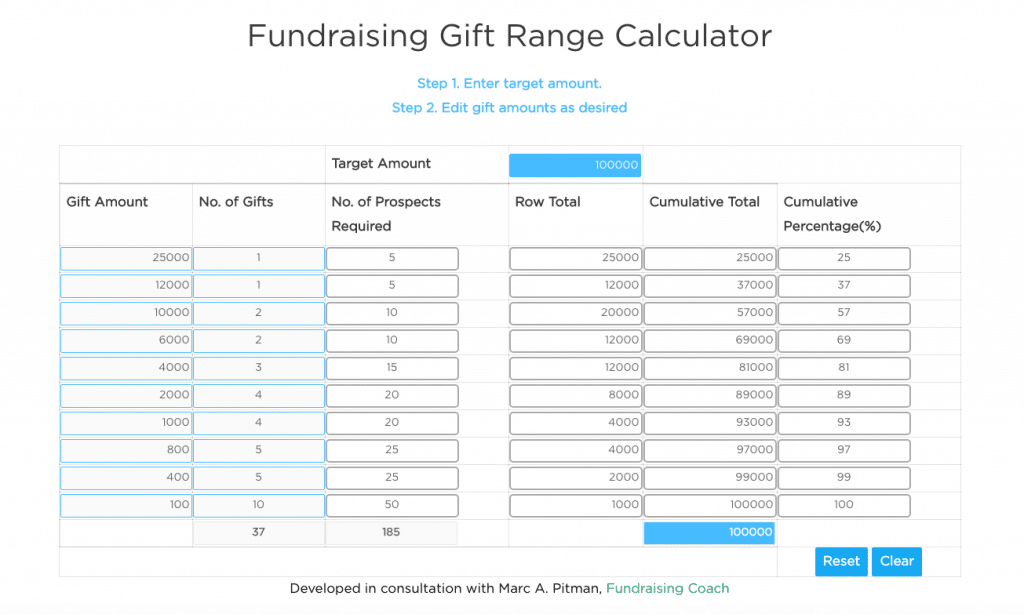1. Gift Range Calculator
The Sumac Gift Range Calculator lets you construct a gift chart automatically to determine how many gifts and prospects you will need to raise a specific amount of money.
Just plug in your goal for a capital campaign or major initiative, and then you can edit the the chart based on what you know about givers and their capacity.
Example: If your goal is $100K, you could break up the first 38K into.
- 1 gift -10K
- 1 gift -7.5K
- 2 gifts – 5K each
- 3 gifts – 3.5K each
You could reach out to a few major donors or apply for grants as well. If you look at the next tier of gifts with a total of $34K, you could run an event or mail campaign, and you can look at planning a series of appeals to cover the remaining 28K.
2. Receipt Value Calculator
Sometimes organizations hold fundraising events, or give gifts that are benefits to donors. Under tax law these are known as “advantages” and in some jurisdictions have to be applied to the Intention to Make a Gift threshold, as well as the de Minimis threshold, in order to determine what amount can go on the donor receipt. Societ made it really easy to determine this amount using the Receipt Value Calculator.

Under Canadian tax law the Intention to Make a Gift Threshold stipulates that when the fair market value (FMV) of an advantage received by a donor is 80% of the FMV of the gift or donation itself, no receipt can be issued.
Example: Someone donates $100 to a nonprofit and receives a ticket to an event valued at $50.
- FMV of gift $100
- FMV of advantage (ticket received) $50
- Intention threshold (80% of FMV of gift) $80
As you can see, the FMV of the advantage received by the donor, which was $50, falls within the threshold of $80, so the nonprofit can write out a receipt.
The de Minimis threshold literally means that the law should not get involved when what has occurred is “trivial.” If advantages have an FMV not more than $75 or 10% of the FMV of the gift (whichever is less) they do not have to be subtracted when issuing receipts.
Example: A person donates $100 and receives a t-shirt worth $6 and a mug valued at $2
- FMV of gift $100
- Value of advantages $8
- de Minimus threshold (lesser of 75% or 10% of value of gift) $10
The combined value of the advantages, which was $8 is less than the de Minimis threshold of $10, so these advantages do not have to be subtracted when issuing the receipt. If the FMV of advantages was more than $80, the organization would not be able to issue a receipt.
3. Monthly Giving Calculator
We worked with monthly giving expert, Erica Waasdorp to develop two easy-to-use monthly giving calculators; a Monthly Giving Benefit Calculator and a Monthly Donor Lifetime Value Calculator.

Many organizations are able to convert anywhere from 5 % to 10 % to monthly donors, others have 20% to 50% recurring donors. With the Monthly Giving Benefit Calculator, if you enter that you raised $100,000 last year and had 1,500 one-time gifts, the chart automatically calculates how much more money you would have raised if you converted 5% to monthly donors at say $20 dollars and 10% to monthly donors at $20 etc. By the way, just converting 5% would give you an extra $13,000+.
With the Monthly Donor Lifetime Value Calculator, you simply enter the number of monthly donors you think you can get, and the average monthly amount you think they will give, for instance $25. The calculator will automatically populate how much revenue that adds up to in year 1, year 2, year 3 etc. If you can get 50 donors to give $25 per month, the lifetime value after 6 years is $90,000 gross, as seen on the example below.
Fundraising Calculators and Giving Trends
By turning to nonprofit fundraising calculator tools you give yourself a visually apparent view of what you are accomplishing or if/when you need to step up your efforts. The tools outlined here make a normally complicated process, much easier. Along with these tools it’s important to keep an eye on giving trends, for example market research seems to suggest that many organizations are relying more and more on large donations to conceal a decline in giving by smaller donors. In the coming months working towards making donations a common behavior could be just what your nonprofit needs to reach or exceed objectives.



